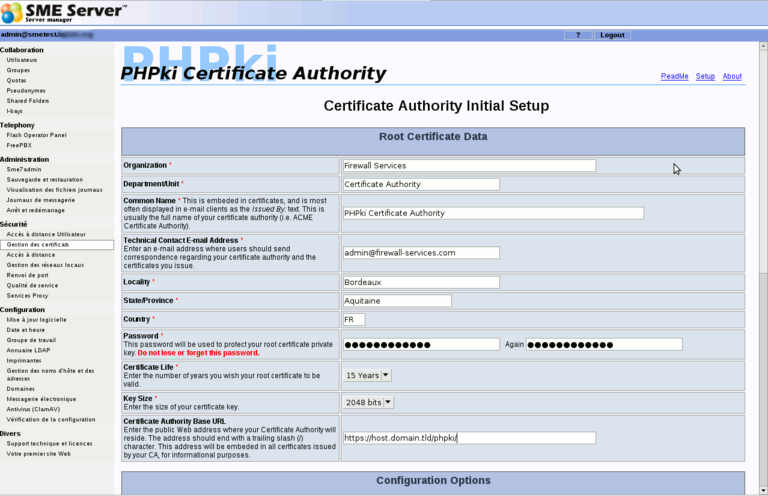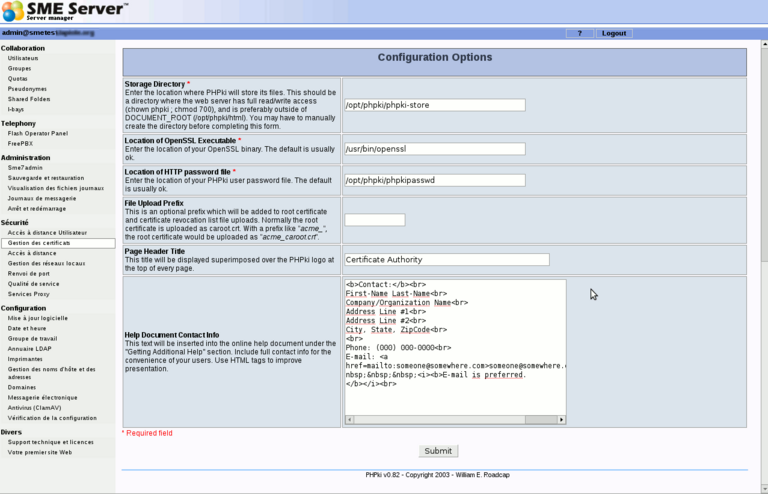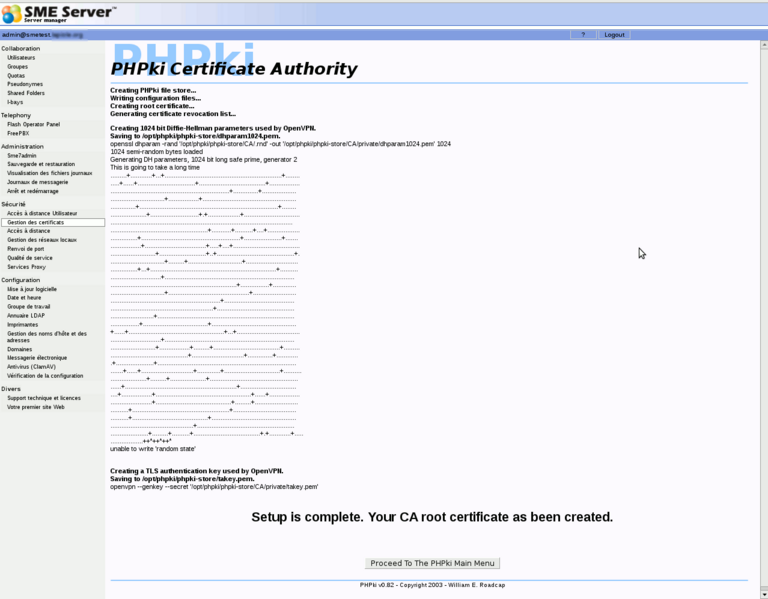Difference between revisions of "PHPki/fr"
| Line 98: | Line 98: | ||
Ici, les utilisateurs peuvent télécharger les Certificats Master CA, CRL, ou chercher les certificats des autres utilisateurs (uniquement dans la partie public bien sûr). | Ici, les utilisateurs peuvent télécharger les Certificats Master CA, CRL, ou chercher les certificats des autres utilisateurs (uniquement dans la partie public bien sûr). | ||
| − | {{Note box|Si vous installez juste la contrib [[OpenVPN_Bridge]] et avez installé PHPki | + | {{Note box|Si vous installez juste la contrib [[OpenVPN_Bridge]] et avez installé PHPki comme recommandé sur la page Wiki, ou vous voulez juste utiliser [[PHPki]] sans la contrib [[OpenVPN_Bridge]], alors vous avez terminé, et vous n'avez donc pas besoins de migrer les certificats}} |
=== Migration des certificats pour l'installation des versions précédentes de la contribs OpenVPN-Bridge === | === Migration des certificats pour l'installation des versions précédentes de la contribs OpenVPN-Bridge === | ||
| − | + | Si vous avez intallé cette contrib PHPki parceque vous avez utilisié [[OpenVPN_Bridge]] avant et que vous avez déjà des certificats, suivez les instructions suivantes. | |
| + | Cependant, si vous avez une installation neuve de [[OpenVPN_Bridge]], ne suivez pas ces instructions, car vous n'avez aucuns "aciens" certificats. | ||
| − | PHPki | + | PHPki est maintenant le gestionnaire de certificat recommander pour [[OpenVPN_Bridge]]. |
| − | + | Cette partie va vous expliquer comment importer vous certificats créer avec openvpn-bridge dans PHPki. | |
| − | * | + | * Premièrement, you need to install the contribs as it's explain on this page (you can enter anything for the configuration of the CA, all your old parameters will be restored) |
* Second, you need to copy this script on your server (for example as /root/migrate.sh) and execute it as root. | * Second, you need to copy this script on your server (for example as /root/migrate.sh) and execute it as root. | ||
Revision as of 15:30, 14 August 2014
Mainteneur
Daniel B. de Firewall Services
Version
Veuillez suivre les instructions d'installation ci-dessous, ils satisferont toutes les dépendances et les dernières versions des 2 RPMs qui seront installés automatiquement.
Description
PHPki est une application OpenSource pour gérer une multi-agency PKI conforme HIPAA. Avec ça, vous pouvez gérer de manière centralisé les certificats X.509 utilisés avec S/MIME activé sur les clients e-mail, Serveurs SSL, et applications VPN. PHPki est maintenant utilisé pour gérer les certificats avec la dernière version de la contrib SME Server OpenVPN Bridge.
Vous pouvez voir la démo d'installation ici
Pré-requis
- SME Server 7.X
Vérifié sur : SME Server 7.4 - RequestedDeletion
Installation
SME Server 7, SME Server 8, SME Server 9
Pour sme8
- Installer les RPMs :
yum --enablerepo=smecontribs install smeserver-phpki
- Puis redémmarer les services :
expand-template /etc/httpd/conf/httpd.conf expand-template /etc/httpd/pki-conf/httpd.conf sv t /service/httpd-e-smith sv u /service/httpd-pki
- Sinon, il est aussi possible de redemmarer le serveur :
signal-event post-upgrade; signal-event reboot
Pour sme9
Vous devez activé le dépôt epel
- Installer les RPMs :
yum --enablerepo=smecontribs,epel install smeserver-phpki
- Puis redémmarer les services :
expand-template /etc/httpd/conf/httpd.conf expand-template /etc/httpd/pki-conf/httpd.conf sv t /service/httpd-e-smith sv u /service/httpd-pki
- Sinon, il est aussi possible de redemmarer le serveur :
signal-event post-upgrade; signal-event reboot
Configurer le nouveau PKI
Dans le Server-Manager, vous trouverez un nouveau menu "Gestion des certificats". Ou vous pouvez utilisez le lien suivant : https://server.domain.tld/phpki/ca
Vous pouvez entrer les informations suivantes :
- Organisation
- Department
- Common Name of the Master CA
- E-mail (technical contact)
- City
- State
- Country Code
- Password (to protect the private key of the Master CA)
- Validity of the CA
- Keys size
- URL of your PKI (https://my.domain.tld/phpki)
Cette image montre la première (et la plus importante) partie de cette page de configuration :
La seconde partie ressemble à ceci :
La configuration par default devrais être OK pour la plupart des installations. Vous pouvez juste changer la partie "Help Document Contact Info".
Une fois ce formulaire rempli (ce qui peut prendre plusieurs minutes), vous devriez avoir quelque chose comme ceci :
Maintenant, PHPki est prêt. Il est très simple à utilisé.
Il est accessible dans le Server-Manager ou vous pouvez utilisez le lien suivant : https://server.domain.tld/phpki/ca
Il existe aussi une interface public, disponible uniquement sur les réseaux locaux, mais sans mot de passe, sur https://my.domain.tld/phpki.
Ici, les utilisateurs peuvent télécharger les Certificats Master CA, CRL, ou chercher les certificats des autres utilisateurs (uniquement dans la partie public bien sûr).
Migration des certificats pour l'installation des versions précédentes de la contribs OpenVPN-Bridge
Si vous avez intallé cette contrib PHPki parceque vous avez utilisié OpenVPN_Bridge avant et que vous avez déjà des certificats, suivez les instructions suivantes. Cependant, si vous avez une installation neuve de OpenVPN_Bridge, ne suivez pas ces instructions, car vous n'avez aucuns "aciens" certificats.
PHPki est maintenant le gestionnaire de certificat recommander pour OpenVPN_Bridge. Cette partie va vous expliquer comment importer vous certificats créer avec openvpn-bridge dans PHPki.
- Premièrement, you need to install the contribs as it's explain on this page (you can enter anything for the configuration of the CA, all your old parameters will be restored)
- Second, you need to copy this script on your server (for example as /root/migrate.sh) and execute it as root.
#!/bin/bash
# Read Openvpn-Bridge DB
ORGNAME=$(/sbin/e-smith/db openvpn-bridge getprop default_config organizationName)
COUNTRY=$(/sbin/e-smith/db openvpn-bridge getprop default_config countryCode)
STATE=$(/sbin/e-smith/db openvpn-bridge getprop default_config countryName)
LOC=$(/sbin/e-smith/db openvpn-bridge getprop default_config localityName)
DEP=$(/sbin/e-smith/db openvpn-bridge getprop default_config sectionName)
KEYSIZE=$(/sbin/e-smith/db openvpn-bridge getprop default_config keySize)
EMAIL=$(/sbin/e-smith/db openvpn-bridge getprop default_config mailAddress)
OPENSSL=/usr/bin/openssl
OLDDIR=/etc/openvpn/easy-rsa/keys/bridge/
NEWDIR=/opt/phpki/phpki-store/CA/
# Store the actual time in $TIME
TIME=$(date +%d%m%Y%H%M%S)
# Create needed directories
prepare_dir(){
mkdir -p $NEWDIR/{certs,newcerts,requests,pfx,private}
}
# Migrate the certificates to phpki store
migrate_certs(){
cd $OLDDIR
# Copy the old index.txt and serial
cat $OLDDIR/index.txt > $NEWDIR/index.txt
cat serial > $NEWDIR/serial
# Copy the cacert related files
cat ca.crt > $NEWDIR/certs/cacert.pem
cat ca.key > $NEWDIR/private/cakey.pem
# Now, for each file ending with .crt
for CERT in $(ls ./*.crt); do
CERT=$(basename $CERT .crt)
ISININDEX=$(grep -c "/CN=$CERT/" $NEWDIR/index.txt)
# If the current cert isn't referenced in the index,
# or the corresponding key or csr file dosn't exists, then skip it
# This can happen in some situation where the serial has been corrupted
if [ $ISININDEX -gt 0 ]&&[ -s $CERT.key ]&&[ -s $CERT.csr ]; then
# Retrieve the serial number as reported by openssl
SERIAL=$(openssl x509 -noout -serial -in $CERT.crt | cut -d"=" -f 2)
# Create the pem only cert in the new dir
$OPENSSL x509 -in $CERT.crt -inform PEM -outform PEM -out $NEWDIR/newcerts/$SERIAL.pem
# Create the der formated cert
$OPENSSL x509 -in $CERT.crt -inform PEM -outform DER -out $NEWDIR/certs/$SERIAL.der
# And the pkcs12 bundle (cert+key+ca)
$OPENSSL pkcs12 -export -in $CERT.crt -inkey $CERT.key -certfile ca.crt -caname $ORGNAME -passout pass: -out $NEWDIR/pfx/$SERIAL.pfx
# Copy the private key
cat $CERT.key > $NEWDIR/private/$SERIAL-key.pem
# And the cert request
cat $CERT.csr > $NEWDIR/requests/$SERIAL-req.pem
fi
done
}
perms(){
# Restrict access
chown -R phpki:phpki $NEWDIR
chmod -R o-rwx $NEWDIR
}
phpki_conf(){
# Retrieve the common name of our CA with openssl command
CACN=$($OPENSSL x509 -subject -noout -in $OLDDIR/ca.crt | cut -d'=' -f 8 | cut -d'/' -f 1)
if [ -e /opt/phpki/phpki-store/config/config.php ]; then
# Move the actual phpki configuration file
mv /opt/phpki/phpki-store/config/config.php /opt/phpki/phpki-store/config/config.php.$TIME
# And use sed to configure it properly
sed -e "s/config\['organization'\].*/config\['organization'\] = '$ORGNAME';/" \
-e "s/config\['unit'\].*/config\['unit'\] = '$DEP';/" \
-e "s/config\['contact'\].*/config\['contact'\] = '$EMAIL';/" \
-e "s/config\['locality'\].*/config\['locality'\] = '$LOC';/" \
-e "s/config\['province'\].*/config\['province'\] = '$STATE';/" \
-e "s/config\['country'\].*/config\['country'\] = '$COUNTRY';/" \
-e "s/config\['common_name'\].*/config\['common_name'\] = '$CACN';/" \
-e "s/config\['ca_pwd'\].*/config\['ca_pwd'\] = '';/" \
-e "s/config\['keysize'\].*/config\['keysize'\] = '$KEYSIZE';/" \
/opt/phpki/phpki-store/config/config.php.$TIME \
> /opt/phpki/phpki-store/config/config.php
fi
}
migrate_var(){
# Here, we just migrate dhparam and ta to phpki store
if [ -e $OLDDIR/dh.pem ]; then
cat $OLDDIR/dh.pem > $NEWDIR/private/dhparam1024.pem
fi
if [ -e $OLDDIR/ta.key ]; then
cat $OLDDIR/ta.key > $NEWDIR/private/takey.pem
fi
}
prepare_dir
migrate_certs
phpki_conf
migrate_var
perms
Now, go in the server-manager, in "Manage Certificates" and check your old certificates are here.
Désintallation
To uninstall the contrib from your server, just run the following commands:
yum remove smeserver-phpki phpki expand-template /etc/httpd/conf/httpd.conf sv t /service/httpd-e-smith
Certificates and PKI configuration are stored in /opt/phpki/phpki-store, php files are in /opt/phpki/html
Ré-installation
If you have removed the contrib, and want to re-install it, you'll need to follow these steps after you have installed the rpms:
cd /opt/phpki/html/ rm -f index.php rm -f setup.php ln -s main.php index.php cat config.php.rpmsave > config.php cd ca rm -f index.php ln -s main.php index.php
Bugs
Please raise bugs under the SME-Contribs section in bugzilla and select the smeserver-phpki component or use this link


